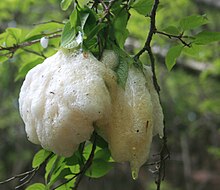
Summary
Rhacophorus is a genus of frogs in the shrub-frog family Rhacophoridae, which, with the related Hylidae, is one of the two genera of true tree frogs. They are found in China, India, Japan, and throughout Southeast Asia, including the island of Borneo. Over 40 species are currently recognised.[1]
| Rhacophorus | |
|---|---|

| |
| Malabar gliding frog (Rhacophorus malabaricus) Note the elongated toes with prominent webbing. | |
| Scientific classification | |
| Domain: | Eukaryota |
| Kingdom: | Animalia |
| Phylum: | Chordata |
| Class: | Amphibia |
| Order: | Anura |
| Family: | Rhacophoridae |
| Subfamily: | Rhacophorinae |
| Genus: | Rhacophorus Kuhl & Van Hasselt, 1822 |
| Species | |
|
See text | |
| Synonyms | |
| |
These frogs have long toes with strong webbing between them, enabling the animals to strategically jump from tree to tree when threatened, using their webbing to gracefully “fall”, controlling their descent into a gliding motion. This is a form of arboreal locomotion known as parachuting.[2] This behavioral adaptation is the source of their common name, "flying frogs".
The present genus is closely related to Polypedates, which (formerly) was included in Rhacophorus. Even today, it is not fully agreed upon which of these genera "P." feae and the Chinese flying frog ("R." dennysi) properly belong to; furthermore, a supposedly new species, "P. pingbianensis", has been found to be the same as R. duboisi.

Reproduction edit
These frogs lay their eggs in aerial foam nests; upon hatching, tadpoles drop to the water under the nest and complete their development there.[3][4] Some species like Rhacophorus kio will wrap this and cover this foam nest with leaves.[5]
Species edit
These species are recognised in the genus Rhacophorus:[1][6][7]
- Rhacophorus annamensis Smith, 1924 – Annam flying frog
- Rhacophorus baluensis Inger, 1954
- Rhacophorus barisani Harvey, Pemberton, and Smith, 2002
- Rhacophorus bengkuluensis Streicher, Hamidy, Harvey, Anders, Shaney, Kurniawan, and Smith, 2014
- Rhacophorus bifasciatus Van Kampen, 1923
- Rhacophorus bipunctatus Ahl, 1927 (including R. htunwini)
- Rhacophorus borneensis Matsui, Shimada, and Sudin, 2013
- Rhacophorus calcadensis Ahl, 1927 – Kalakad gliding frog
- Rhacophorus calcaneus Smith, 1924
- Rhacophorus catamitus Harvey, Pemberton, and Smith, 2002
- Rhacophorus edentulus Müller, 1894
- Rhacophorus exechopygus Inger, Orlov, and Darevsky, 1999
- Rhacophorus georgii Roux, 1904
- Rhacophorus helenae Rowley, Tran, Hoang & Le, 2012[6] – Helen's tree frog
- Rhacophorus hoabinhensis Nguyen, Pham, Nguyen, Ninh, and Ziegler, 2017
- Rhacophorus hoanglienensis Orlov, Lathrop, Murphy, and Ho, 2001
- Rhacophorus indonesiensis Hamidy & Kurniati, 2015
- Rhacophorus kio Ohler & Delorme, 2005 – black-webbed treefrog
- Rhacophorus laoshan Mo, Jiang, Xie, and Ohler, 2008
- Rhacophorus larissae Ostroshabov, Orlov, and Nguyen, 2013
- Rhacophorus lateralis Boulenger, 1883
- Rhacophorus malabaricus Jerdon, 1870 – Malabar gliding frog
- Rhacophorus margaritifer (Schlegel, 1837)
- Rhacophorus marmoridorsum Orlov, 2008
- Rhacophorus modestus Boulenger, 1920
- Rhacophorus monticola Boulenger, 1896
- Rhacophorus napoensis Li, Liu, Yu, and Sun, 2022
- Rhacophorus nigropalmatus Boulenger, 1895 – Wallace's flying frog
- Rhacophorus norhayatii Chan and Grismer, 2010
- Rhacophorus orlovi Ziegler and Köhler, 2001
- Rhacophorus pardalis Günther, 1858 – harlequin tree frog
- Rhacophorus poecilonotus Boulenger, 1920
- Rhacophorus pseudomalabaricus Vasudevan and Dutta, 2000
- Rhacophorus reinwardtii (Schlegel, 1840) – black-webbed tree frog, green flying frog, Reinwardt's tree frog
- Rhacophorus rhodopus Liu and Hu, 1960 (including R. namdaphaensis, often included in R. bipunctatus)
- Rhacophorus robertingeri Orlov, Poyarkov, Vassilieva, Ananjeva, Nguyen, Sang, and Geissler, 2012
- Rhacophorus spelaeus Orlov, Gnophanxay, Phimminith, and Phomphoumy, 2010
- Rhacophorus subansiriensis Mathew and Sen, 2009
- Rhacophorus trangdinhensis Kropachev, Evsyunin, Orlov, and Nguyen, 2022
- Rhacophorus translineatus Wu, 1977
- Rhacophorus tuberculatus (Anderson, 1871)
- Rhacophorus turpes Smith, 1940
- Rhacophorus vanbanicus Kropachev, Orlov, Ninh, and Nguyen, 2019
- Rhacophorus verrucopus Huang, 1983
- Rhacophorus viridimaculatus Ostroshabov, Orlov, and Nguyen, 2013
Phylogeny edit
The following is a partial phylogeny of Rhacophorus from Pyron & Wiens (2011).[8] Only nine species are included. Rhacophorus is a sister group of Polypedates.[8]
References edit
- ^ a b Frost, Darrel R. (2013). "Rhacophorus". Amphibian Species of the World 5.6, an Online Reference. American Museum of Natural History. Retrieved 15 April 2013.
- ^ John R. Hutchinson. "Gliding and Parachuting". www.ucmp.berkeley.edu. Regents of the University of California.
- ^ Grosjean, S.; Delorme, M.; Dubois, A.; Ohler, A. (2008). "Evolution of reproduction in the Rhacophoridae (Amphibia, Anura)". Journal of Zoological Systematics and Evolutionary Research. 46 (2): 169. doi:10.1111/j.1439-0469.2007.00451.x.
- ^ Li, Jiatang; Dingqi Rao; Robert W. Murphy; Yaping Zhang (2011). "The systematic status of rhacophorid frogs" (PDF). Asian Herpetological Research. 2: 1–11. doi:10.3724/SP.J.1245.2011.00001.
- ^ Poo, Sinland (2016). "RHACOPHORUS KIO. OVIPOSITION AND NEST CONSTRUCTION". Herpetological Review. 47 (1): 119–120.
- ^ a b Rowley, J. J. L.; Tran, D. T. A.; Hoang, H. D.; Le, D. T. T. (2012). "A new species of large flying frog (Rhacophoridae: Rhacophorus) from lowland forests in southern Vietnam". Journal of Herpetology. 46 (4): 480–487. doi:10.1670/11-261. S2CID 86411409.
- ^ Kropachev, Ivan I.; Orlov, Nikolai L.; Ninh, Hoa Thi; Nguyen, Tao Thien (2019-12-15). "A New Species of Rhacophorus Genus (Amphibia: Anura: Rhacophoridae: Rhacophorinae) from Van Ban District, Lao Cai Province, Northern Vietnam". Russian Journal of Herpetology. 26 (6): 325–334. doi:10.30906/1026-2296-2019-26-6-325-334. ISSN 1026-2296. S2CID 216378292.
- ^ a b R. Alexander Pyron; John J. Wiens (2011). "A large-scale phylogeny of Amphibia including over 2800 species, and a revised classification of extant frogs, salamanders, and caecilians". Molecular Phylogenetics and Evolution. 61 (2): 543–583. doi:10.1016/j.ympev.2011.06.012. PMID 21723399.
External links edit
- Amphibian and Reptiles of Peninsular Malaysia - Family Rhacophoridae


